.
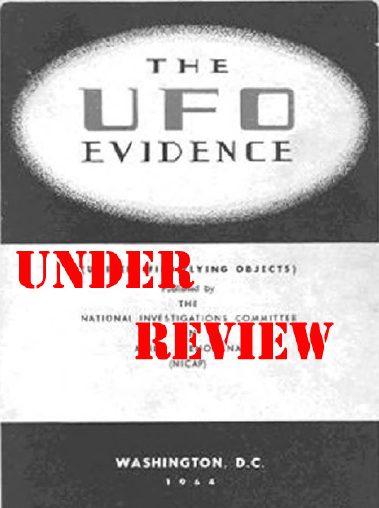
September 21, 1961
The UFO evidence summarizes the case as:
September 21, 1961--Pacific Ocean, nr. Wake Island. Airline pilots, ship, reported a bright white circular UFO. [X]1
Section X has a much longer description of the event:
For about 10 minutes at 7:00 a.m. (Honolulu time), September 21, 1961, two airliners and a U.S. ship at sea observed a UFO simultaneously. The object passed overhead, apparently at extremely high altitude, angling southeasterly above the North Pacific. (See map.)
Reports from the Federal Aviation Agency, and the U.S. Navy Oceanographic Office publication “Notice to Mariners,” establish the following facts.
At 1700 Greenwich Mean Time, the S.S. Iberville, north and east of Midway Island, noticed a white
object about 20 degrees above the NW horizon. Its apparent angular size was about I degree
(twice the apparent size of the full moon). For about 10 minutes, the UFO was observed passing
over the ship headed southeast. As it neared the ship’s meridian, it resembled a huge halo with a
bright object in the center. The apparent size in creased to over four times the size of the full moon. [See Notice to Mariners report, repro- duced below.]
At the same time, a British Overseas Airways Corporation (BOAC) airliner about 800 miles northeast of the ship saw the object overtake the plane. From a steep angle above the plane, the UFO continued southeasterly and disappeared over the horizon. Capt. H. F. Griffin described the UFO as “like a large smoke ring about 2 degrees in diameter [about 4 times the size of the full moon].” He said the center of the ring was clear sky, and once a star was visible through it. A ray of light seemed to project downward from the object.
A Pan American Airways plane, about 400 miles southeast of Capt. Griffin’s position, confirmed the report. The pilot reported a doughnut- shaped object moving easterly about l0 degrees above the horizon. 2
The description includes a map which shows the position of the ship and aircraft to be north and east of Midway island. There is also a reproduction of the Notice to Mariners report made by the second officer of the SS Iberville. It reads:
At 1700 G.M.T. on September 21, 1961, while in lat. 31° 30’ N., long. 175° 30’ E., a few minutes before morning twilight, a white opaque mass about twice the size of a full moon appeared in the northwest at an elevation of about 20°. It continued to climb toward the zenith and at about an elevation of 40°, the mass opened gradually to appear as a huge halo with a satellite in the center having very nearly the brightness of a first magnitude star. By the time it reached the zenith, it had more than doubled in size reaching its maximum at the zenith and then diminishing as it proceeded to the southeast. As it diminished it continued to decrease in size but did not appear to shrink into a corona as it had appeared but rather faded out completely at an elevation of approximately 20°. The entire mass was in view for approximately 8 to 10 minutes.3
NICAP would add the following comment about the case in their UFO evidence document:
The Soviet Union announced a few days later that they had successfully test fired a multi-stage carrier rocket over the Pacific (exact date not on record). However, the reported size of the UFO was far too large to be explained as a rocket payload.4
They would also write in their UFO Investigator, the following:
Based on first reports, these points seem evident:
1. The object was not an ICBM missile. Nor was it a satellite re-entering the atmosphere. These appear only as small balls of fire, briefly visible.
2. The reflected light was from the sun, which was an hour below the horizon. The UFO had to be very high to catch its rays.
3. At such a high altitude, the unknown device had to be extremely large (at least several hundred feet in diameter) for its edges and the hole to be so clearly seen by the BOAC crew. The size and description rule out all earth-made rockets, satellites, or Echo-type bal- loons.
The “doughnut” shape the jet crews reported is similar to the future space-base proposed by rocket expert Wernher von Braun--a huge doughnut-shaped ring containing compartments for crews and equipment and rotating to create gravity. At a distance, the connecting framework would be invisible, and from far below, the space-base would appear just as Capt. Griffin described the UFO.
More advanced space engineers, experimenting on another planet, could have evolved the same type of space-base. It is possible that what the jet crews saw was such a spacecraft from another world. 5(UFO Investigator October 1961 p. 1-2)
This is how NICAP presented its case. There seems to be a wealth of information and the object was seen over a wide area of ocean. This indicates the object was extremely high in the sky. My next stop would be the Blue Book files to check for any additional infor- mation.
Blue Book’s information and conclusion
The Blue Book file is limited and has two teletypes covering the sightings by the airplane crews. The Iberville is not listed in the case file. Some important highlights from these documents were:

1. The position of the BOAC plane was 38.0 North and 161.0 West at 2000Z, which was three hours later.6 Apparently, this is when they filed the report. This position was used by Blue Book and NICAP. No position was given for 1700Z. However, if we work backward based on the reported heading of 83 degrees magnetic and air speed of 550 knots, we discover the position of the plane was approximately 36.25 deg North 164.5 deg East. This is in agreement with the description by the pilot of the sky, which he described as pre-dawn. 1700Z is thirty minutes after sun rise for the 161 degree west position. From the 164.5 degree posi- tion, the sun rose about 1850Z.
2. The BOAC air crew reported the object was about 50 degrees elevation when first sighted and was headed towards an azimuth of about 100 degrees.7
3. The Pan Am plane was located at 34 deg 55 min North and 154 deg 40 min East.8
4. The Pan Am crew reported the object appeared about 10 degrees over the eastern horizon and was headed eastward.9
Blue Book wrote a brief conclusion regarding these sightings10:
Other (MISSILE ACTIVITY). Missile exercise in area at the time of the sighting.
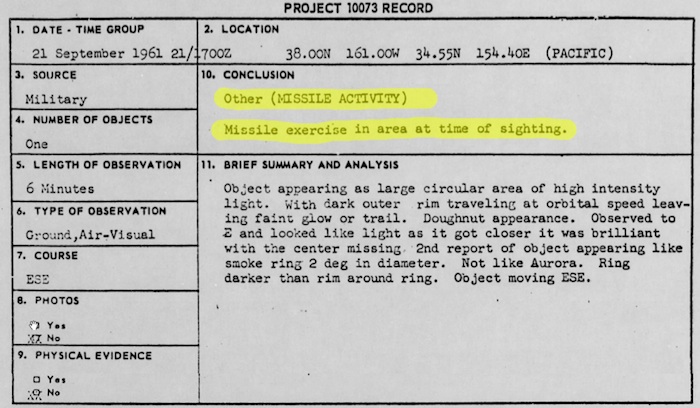
There wasn’t much in regards to who fired the missile and its destination. Before we examine this possibility, we need to fix some mistakes in the UFO evidence document so we can properly evaluate the sighting.
Getting the positions correct
NICAP’s authors present the following map regarding the sightings11:
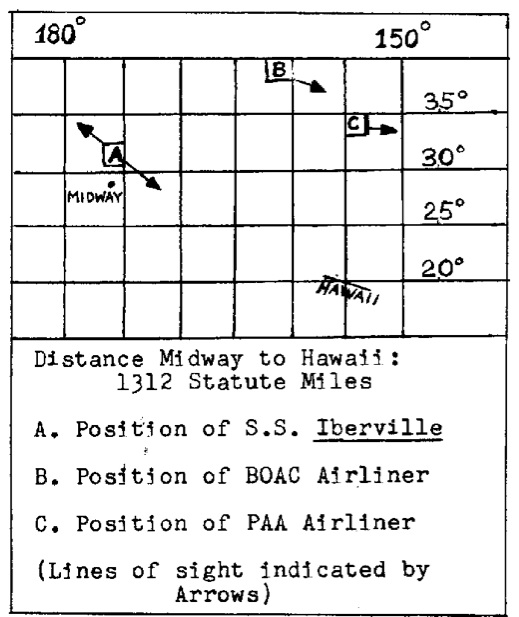
NICAP really did not research this very well because they confused the longitudes of the aircraft and ship. The Pan Am aircraft and Iberville were at EAST longitude and not west longitude. Additionally, the position of the BOAC aircraft was three hours old! As a result the map above is completely inaccurate. This is how the actual positions and sighting lines appear using Google Earth:
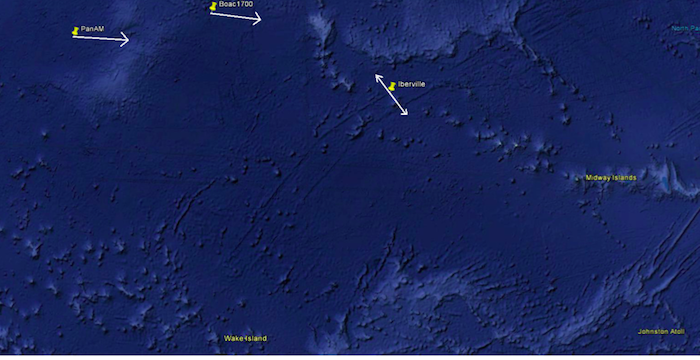
Potential source
In 1961, the Russian’s were ahead in the space race. By September 1961, they had launched a probe to Venus, put the first man in orbit, and Titov had orbited the earth for a full day. Meanwhile, the Russians were testing a variety of ICBM rockets for deployment. Normally, the Soviet Union would launch their payloads to the Kura peninsula. However, in September of 1961, they launched several ICBM payloads towards the Pacific ocean to test the maximum range of their rockets. Unfortunately, the Soviet Union records of these tests is not that extensive. The astronautix web site chronology gives no time for this entry:
1961 September 21 - . Launch Site: Baikonur. Launch Complex: Baikonur LC31. Launch Pad: LC31?. LV Family: R-7. Launch Vehicle: R-7A. LV Configuration: R-7A E15003-03.
R-7A II-7 test - . Nation: USSR. Agency: RVSN. Apogee: 1,350 km (830 mi). Summary: R-7A readiness verification test..12
The date of 21 September is interesting. Baikonur is 6 hours ahead of UTC, which means a launch before 1700 GMT/UTC (the time of the sightings) would have been prior to 2300 Baikonur time on the 21st. So the date is correct. However, was it launched towards the Pacific and what part of the Pacific was targeted?
My search took me to the Newspaper archive, where I found several articles based on an announcement made by TASS about this rocket launch. While they did not state where the payload landed, the UPI drew the following conclusion:
Tass did not give an exact distance for the shot. But previous announcements said that in the two earlier tests the rockets traveled some 7,500 miles into a designated Pacific target area some 1,000 miles southwest of Hawaii. Today’s announcement said the multi-stage car- rier rocket was fired on Thursday (the 21st).13
I was somewhat surprised that the Soviet Union was able to launch an ICBM so near the United States. Wouldn’t such a test appear as an attack? The article answered this by stating that the Soviet Union had warned aircraft and mariners ahead of time about the test. I am sure that the United States was also informed.
I e-mailed Jonathan McDowell, among others, and he agreed that the launch was probably to the southwest of Hawaii. He stated that on page 201 of the book ‘Nezabivayemiy Baykonur’ , the ICBM had been launched at “maximum range”.14 The location of about 1000 miles to the southwest of Hawaii does put the distance traveled around 7500 miles as stated in the news reports.
Using Google earth, I traced the most direct route from Baikonur to this position. It is interesting to note that the trajectory takes it almost directly over the SS Iberville. The directions of observation by the BOAC and Pan Am crews were in the directions of the flight path of the ICBM.
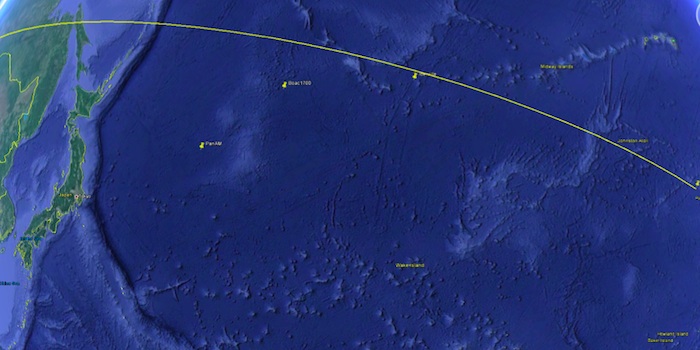
Is it solved?
Unfortunately, we can’t solve this one conclusively because we don’t have a launch time. Maybe somebody can find it but I have had little luck in doing so even though I have contacted several experts on the subject. There are many characteristics in the reports that are what one would expect from this kind of missile test. The R-7A was a liquid fueled rocket and there probably would have been fuel remaining in the booster. As this vented off into space, it would have produced a cloud around the booster which would have been several degrees across and not simply a mere pinpoint of light as suggested in the NICAP documents. The de- scription of the UFO is what one would expect from a booster rocket venting fuel in space. If one couples the direction of travel and directions of observation in the report, it paints a pretty convincing picture that the ICBM test caused this report.
I found NICAP’s knowledge about rocket launches and ICBM tests limited and very biased. One can forgive NICAP in 1961 for mak- ing such comments. The space age was only a few years old and their experience with such sightings was extremely limited even though there was at least one NICAP member who was a missile expert (Retired Rear Admiral Delmer S. Fahrney). However, the promotion of the case a few years later in this document indicated they had yet to learn anything about such tests and how they appeared. NICAP seemed to have been more interested in promoting such cases as “unidentified” than actually pursuing potential explanations. Even more astounding is that many of these cases continue to be presented as “best evidence” on various UFO web sites across the internet. The lessons of the past appear to be ignored.
Unless somebody can produce a launch time that falsifies this potential explanation, I would consider it likely that the Soviet ICBM test produced these sightings. This case is NOT the “best evidence” that UFOs are alien spaceships and should be removed from the list.
Quelle: SUNlite 5/2013


5324 Views
